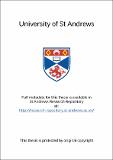Files in this item
Human emotional memory : physiological, pharmacological and neuropsychological investigations
Item metadata
| dc.contributor.advisor | O'Carroll, Ronan | en |
| dc.contributor.author | Papps, Benjamin Philip | en |
| dc.coverage.spatial | 401p | en |
| dc.date.accessioned | 2021-04-08T08:59:24Z | |
| dc.date.available | 2021-04-08T08:59:24Z | |
| dc.date.issued | 2001 | |
| dc.identifier.uri | https://hdl.handle.net/10023/21919 | |
| dc.description.abstract | This thesis addressed the nature of arousal and its impact on human memory by assessing the degree to which response characteristics, stimulus characteristics, pharmacological and neurological characteristics affect memory for emotional material. Understanding the mechanisms by which emotions affect memory may contribute to attempts to ameliorate clinical disorders, which are characterized by intrusive traumatic memories. In experimental Chapter 2, frequency-matched words rated as highly arousing were remembered consistently better than low arousal rated words with a normal pattern of decay over a series of 4 recall intervals occurring over one week in a within-subject design. Galvanic skin responses to the same words that were high or low at the time of stimulus presentation did not predict memory at these intervals. Chapter 3 assessed the role of the central noradrenergic (NA) system in memory for emotional material. Pharmacological processes believed to occur at the time of arousal and which are believed to be involved in the encoding of specifically emotional memories were manipulated. It was predicted that NA re-uptake inhibition would result in an increase in memory for the emotional compared to neutral material. The study demonstrated a dose-dependent effect opposite to the predicted direction. The fourth experimental chapter studied the effects of physiological response characteristics alone on memory. Memory was assessed in subjects who demonstrated low physiological reactivity to images (high 'alexithymics') compared to controls (low 'alexithymics') but who did not demonstrate differences in subjective emotional responses. While differences in physiological reactivity existed between high and low alexithymics, no differences in memory were observed. In Chapter 5, free-recall memory for images combined with incongruent sounds was better than free-recall memory for images that were combined with congruent sounds. Presentations that were rated as unpleasant (low valence) and highly arousing were remembered better than other categories regardless of stimulus incongruity. Chapter 6 investigated hemispheric differences in emotional memory functioning in man. A patient with right amygdala damage showed evidence of an emotional but not neutral memory impairment over four tasks compared to age and education matched healthy controls. By contrast, another patient with damage to the left amygdala performed similarly to the controls on the same tasks. These findings, taken together indicate a) subjective rather than physiological responses to stimuli predict memory performance in healthy adults, b) the interaction of low valence (pleasantness) ratings and high arousal ratings is associated with superior recall in healthy adults, c) the effects of emotion on memory are not due to other stimulus characteristics such as distinctiveness d) that increasing the level of the neurotransmitter noradrenaline (modulated by emotional arousal) does not improve emotional memory and e) the right amygdala in humans may be more critical for emotional memory functioning than the left amygdala in humans. | en |
| dc.language.iso | en | en |
| dc.publisher | University of St Andrews | en |
| dc.subject.lcc | QP401.P2 | |
| dc.subject.lcsh | Emotions | en |
| dc.title | Human emotional memory : physiological, pharmacological and neuropsychological investigations | en |
| dc.type | Thesis | en |
| dc.type.qualificationlevel | Doctoral | en |
| dc.type.qualificationname | PhD Doctor of Philosopy | en |
| dc.publisher.institution | The University of St Andrews | en |
This item appears in the following Collection(s)
Items in the St Andrews Research Repository are protected by copyright, with all rights reserved, unless otherwise indicated.

